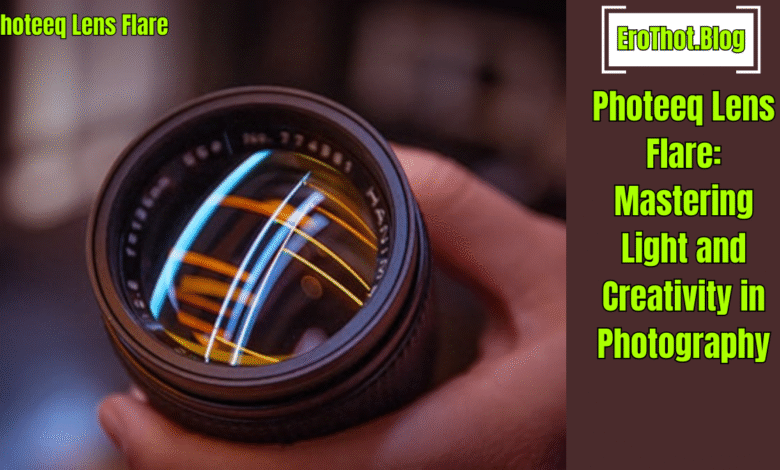Photeeq Lens Flare: Mastering Light and Creativity in Photography

Introduction to Photeeq Lens Flare
When we talk about photography, one of the most magical yet controversial effects has to be the lens flare. It’s that bright burst or streak of light that happens when the sun or another light source hits the camera lens at just the right angle. Some photographers see it as an imperfection, while others embrace it as a tool for adding mood and character to their images. Enter Photeeq lens flare, a concept that goes beyond accidental light leaks and transforms them into purposeful, creative effects.
Photeeq has emerged as a popular name among photographers and digital artists who want more control over light. While lens flare itself is nothing new, Photeeq’s Approach emphasises artistic use, digital enhancement, and software-based tools to give photographers a fresh way of working with light. Instead of waiting for the “perfect” sun angle, you can now experiment with digital overlays, customisable flares, and filters that elevate your shots to a cinematic level.
In this article, we’ll take a deep dive into Photeeq lens flare: what it is, why it matters, how it’s used in creative work, and how you can master it in your photography or design. By the end, you’ll see that lens flare isn’t just a happy accident—it’s a visual storytelling tool that can turn a good image into a breathtaking one.
Understanding the Basics of Lens Flare
Lens flare is essentially scattered light entering the camera lens and bouncing between its elements. This scattering causes glowing circles, streaks, or haze that appear in the photo. While this often happens in bright sunlight, it can also occur with artificial lights such as streetlamps, car headlights, or stage lights. The results vary depending on the lens, the aperture setting, and the positioning of the light source.
Traditionally, lens flare was something photographers tried to avoid. In older film photography, lens coatings weren’t as advanced, so flare could easily ruin contrast and add unwanted glare. Many professionals carried lens hoods or adjusted their positioning to block out flare altogether. But in the digital age, especially with editing software and overlays, lens flare has taken on a new identity. Now, it’s more of a stylistic choice than a mistake.
Photeeq lens flare takes this concept further by offering curated digital flares that mimic the beauty of natural light without the unpredictability. Whether you’re shooting a wedding, a portrait, or a landscape, adding a controlled flare can change the entire mood of the image. It’s like sprinkling a bit of cinematic magic onto your work.
The Rise of Photeeq in Photography
The name Photeeq started gaining attention among photographers who wanted more than just simple filters. Unlike traditional editing tools, Photeeq offered customisable overlays that enhanced photos while maintaining a natural look. Instead of generic effects, users could fine-tune the light streaks, flares, and glares to suit the subject and composition of their shots.
One of the biggest reasons Photeeq lens flare became so popular is its accessibility. You don’t need a $2000 lens to achieve that dreamy glow; you can simulate it digitally with Photeeq’s tools. For beginners, this is especially powerful because it removes the steep technical barrier that often comes with advanced lighting techniques. You can focus more on creativity and less on fighting with gear limitations.
Another reason for Photeeq’s popularity is social media. Platforms like Instagram and Pinterest thrive on visually striking content, and lens flare fits perfectly into that aesthetic. Whether it’s a warm golden-hour portrait or a dramatic cityscape, a touch of Photeeq lens flare can make an image stand out in a crowded feed. As a result, more photographers, influencers, and brands are embracing this effect as part of their creative toolkit.
Why Photographers Love Lens Flare
There’s something about lens flare that feels inherently cinematic. Think about your favourite movies—many of them use flares to add a dreamy, larger-than-life quality to scenes. The same logic applies in photography. A carefully placed flare can create a sense of warmth, romance, or nostalgia that resonates with viewers.
Another reason photographers love lens flare is its ability to add depth and texture. A flat, evenly lit image can look clinical or lifeless. But introduce a burst of flare, and suddenly the photo feels dynamic and full of character. It’s almost like giving your audience a peek behind the curtain, reminding them that the image is grounded in real-world light.
Photeeq lens flare allows photographers to harness this effect without sacrificing control. Instead of waiting for the perfect sunbeam, you can add, adjust, or remove flares in post-production. This gives you the best of both worlds: natural beauty and creative flexibility.
The Science Behind Photeeq Lens Flare
While the artistic side of lens flare gets most of the attention, it’s worth understanding the science behind it. Light travels in straight lines, but when it hits the glass elements inside a lens, it can scatter. This scattering happens because lenses are made of multiple glass layers, each of which bends light differently. The reflections between these layers cause the streaks and circles we recognise as flares.
Photeeq replicates this process digitally by analysing how real lenses behave under different conditions. By simulating these interactions, Photeeq lens flare overlays can mimic natural light scatter in a way that feels authentic. Unlike generic editing software that simply pastes a glow effect, Photeeq’s algorithms produce more realistic results.
This scientific foundation is crucial because it prevents the flare from looking fake or out of place. The last thing you want is a lens flare that distracts from your photo instead of enhancing it. Photeeq balances the technical and artistic sides to give photographers tools that are grounded in real-world physics.
Creative Applications of Photeeq Lens Flare
Lens flare isn’t just about making a photo look pretty—it’s about telling a story. For instance, adding a subtle flare to a wedding photo can emphasise the intimacy and warmth of the moment. In travel photography, a flare can highlight the golden glow of a sunrise or the neon buzz of a city at night. The creative possibilities are endless.
One of the most exciting uses of Photeeq lens flare is in branding and marketing. Companies often want their visuals to feel aspirational and cinematic. Adding controlled flares to product shots or promotional content helps achieve this goal. A skincare ad, for example, might use a soft glow to suggest freshness and radiance. Similarly, a tech brand might incorporate sharp, futuristic flares to align with its sleek image.
Another area where Photeeq lens flare shines is in social media storytelling. Influencers and creators often use flair to give their posts a distinct vibe. Whether it’s the dreamy haze of a morning coffee shot or the energetic sparkle of a music festival, flares add a layer of mood that simple filters can’t replicate.
How to Use Photeeq Lens Flare Effectively
While lens flare can elevate your work, it’s essential to use it wisely. Overdoing it can make your photos look artificial or distracting. The key is balance. Think of flare as a spice—you want just enough to enhance the flavour without overpowering the dish.
Start by considering the mood you want to create. A subtle, warm flare works well for romantic portraits or cosy lifestyle shots. On the other hand, bold, dramatic flares are better suited for cinematic landscapes or edgy fashion photography. Photeeq gives you the flexibility to choose from different styles and intensities, so experiment until you find the perfect fit.
Another tip is to pay attention to placement. A flare that cuts across a subject’s face might feel distracting, while one that frames them softly can add magic. With Photeeq tools, you can reposition and resize the effect to fit your composition seamlessly. Remember: the goal is to enhance, not overpower.
The Difference Between Natural and Photeeq Lens Flare
Some photographers argue that nothing beats the authenticity of a natural lens flare. They’re not wrong—there’s a certain magic to capturing light in its raw form. However, natural flares are unpredictable. You might spend hours chasing the perfect angle only to end up with results that don’t fit your vision.
Photeeq lens flare bridges that gap by giving you creative control. While natural flares are bound by weather, time of day, and equipment, digital overlays are not. You can add them to any photo at any time. This doesn’t make them less “authentic”—it just means you have more flexibility to tell the story you want.
The difference ultimately comes down to intention. If you want the spontaneity of capturing light in the moment, go for natural flare. If you want precision and control, Photeeq is your best friend. Many photographers even combine both approaches, enhancing a natural flair with Photeeq to achieve the best of both worlds.
Photeeq Lens Flare in Cinematic Photography
Cinema has always been a significant influence on photography trends, and lens flare is a perfect example of this. From sci-fi epics to romantic dramas, filmmakers use flares to set the tone of a scene. Photeeq brings this cinematic style into everyday photography, allowing creators to channel the same energy without expensive equipment.
Imagine shooting a portrait with a dramatic Photeeq flare cutting across the frame—it instantly feels like a movie poster. Or picture a cityscape enhanced with neon-colored flares that mimic the vibe of futuristic films. These cinematic touches not only make photos visually striking but also help them tell a more compelling story.
Photographers who want to give their portfolios a cinematic edge often rely on Photeeq lens flare to stand out. It’s one of those small details that can transform a good shot into something unforgettable.
Tips for Beginners Using Photeeq Lens Flare
If you’re new to lens flare, start small. Many beginners make the mistake of cranking up the effect because it looks cool. But subtlety often works better. Try adding just a touch of flair to see how it changes the mood of your photo. From there, you can gradually experiment with more dramatic effects.
Another tip is to practice with different kinds of images. Don’t just stick to portraits or landscapes—try adding flair to still life, architecture, or even product shots. This will help you understand how light interacts with different subjects and compositions.
Finally, study how professionals use flare. Look at movie stills, fashion magazines, and top Instagram accounts for inspiration. Notice how flares are often strategically placed and balanced. The more you analyse, the better you’ll get at using Photeeq lens flare in your creative work.
Common Mistakes to Avoid
While lens flare is powerful, it can backfire if misused. One common mistake is overexposure. Adding too much flare can wash out your image and reduce clarity. Always keep an eye on contrast and detail when applying the effect.
Another mistake is poor placement. If the flare cuts across your subject’s eyes or key details, it can be distracting. Remember, the flare should complement the subject, not compete with it. With Photeeq, you have the advantage of being able to reposition effects, so take the time to adjust carefully.
Lastly, avoid relying on flare as a crutch. A weak composition or poorly lit photo won’t magically become amazing just because you added a flare. Think of it as the finishing touch, not the main ingredient. A strong foundation in lighting, framing, and storytelling is still essential.
The Future of Photeeq Lens Flare
As technology continues to evolve, tools like Photeeq will only get more advanced. We’re already seeing AI-driven editing software that can analyse an image and suggest the best flare placement automatically. In the future, we might even see real-time flare simulations in cameras, giving photographers instant previews of how their shots will look with different effects.
Photeeq’s role in this future is likely to grow, especially as demand for cinematic, visually striking content continues to rise. With social media, advertising, and entertainment constantly pushing creative boundaries, lens flare is here to stay as a go-to effect.
For photographers, the future is exciting. Instead of fearing flare as a mistake, we now have the tools to embrace it as a form of artistic expression. Photeeq lens flare is more than just an effect—it’s a bridge between science and art, control and creativity, reality and imagination.
Conclusion
Photeeq lens flare represents a shift in how photographers and creators view light. What was once seen as an imperfection is now celebrated as a storytelling tool. With Photeeq’s digital overlays and editing tools, anyone—from beginners to professionals—can harness the beauty of flare without the unpredictability of natural light.
Whether you’re trying to give your wedding photos a dreamy glow, your travel shots a cinematic edge, or your brand visuals a unique identity, Photeeq lens flare offers the flexibility and control you need. It’s not just about adding light—it’s about adding life.
FAQs About Photeeq Lens Flare
1. What is Photeeq lens flare?
Photeeq lens flare refers to a collection of digital tools and overlays designed to replicate natural light flares in photography. Unlike random light leaks, Photeeq allows photographers to control the style, placement, and intensity of the flare.
2. Is Photeeq lens flare better than natural flare?
Not necessarily—it depends on your goals. Natural flare offers authenticity, while Photeeq provides flexibility and control. Many photographers use a mix of both to achieve the perfect balance.
3. Can beginners use Photeeq lens flare effectively?
Absolutely. Photeeq is beginner-friendly and doesn’t require advanced gear or technical expertise. The key is to start subtle and experiment with different styles until you find what works.
4. Does lens flare reduce image quality?
Too much flare can reduce contrast and clarity, but when used wisely, it enhances the mood without hurting quality. Photeeq’s overlays are designed to look natural and maintain image sharpness.
5. Where can I use Photeeq lens flare?
Photeeq lens flare works in various photography niches: weddings, portraits, landscapes, branding, advertising, and social media. It’s versatile enough to add mood and storytelling value to almost any type of photo.

